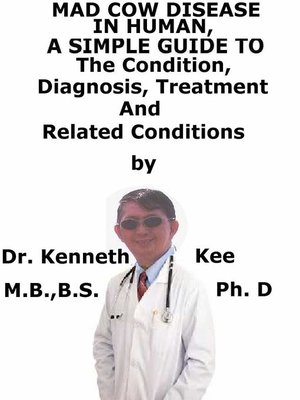Mad Cow Disease In Humans, a Simple Guide to the Condition, Diagnosis, Treatment and Related Conditions
ebook
By Kenneth Kee

Sign up to save your library
With an OverDrive account, you can save your favorite libraries for at-a-glance information about availability. Find out more about OverDrive accounts.
Find this title in Libby, the library reading app by OverDrive.



Search for a digital library with this title
Title found at these libraries:
| Library Name | Distance |
|---|---|
| Loading... |
This book describes Mad Cow Disease in humans, Diagnosis and Treatment and Related DiseasesEver since the first TV and newspaper pictures of Mad Cow Disease with cows falling on their legs and foaming at the mouth appear in 1990s, many people in Singapore and worldwide have been fearful of taking beef.Even the popular Bovril extract made of beef has its ingredients of beef changed to vegetablesMad Cow Disease or Bovine Spongiform Encephalopathy (BSE) is an infectious disease caused by prions that affect the brains of cattle.When humans eat diseased tissue from cattle, they may form the human form of mad cow disease known as variant Creutzfeldt-Jakob disease (vCJD) or new variant Creutzfeldt-Jakob disease (nvCJD).Creutzfeldt-Jakob disease in the classic form normally happens in older people either through an inherited tendency of the brain to change or the disease happens naturally for no apparent reason.The form diagnosed as occurring from eating diseased cattle happens in younger people and has abnormal medical features, with outstanding psychiatric or sensory symptoms at the time of medical presentation and delayed start of neurological abnormalities.These neurological abnormalities are:1. Ataxia within weeks or months,2. Dementia (loss of memory and confusion) and3. Myoclonus late in the illness,4. A duration of illness of at least six months, and5. A diffusely abnormal non-diagnostic electroencephalogram.The transmissible causes that produce the disease in both cattle and humans are atypical protein particles called prions.Prions are not like bacteria or viruses that cause other infectious diseases; rather, they are considered infectious abnormal proteins that are able to induce abnormal folding of specific normal cellular proteins.The abnormal prions are found in the brain, spinal cord, eye (in the retina), and other tissues of the nervous system of affected animals or humansAll prion diseases are fatal.Animals and humans who develop a prion disease will die of it.There is no effective treatmentSymptomsInfected adult cattle may develop signs of the disease slowly.It may take from two to eight years from the time an animal becomes infected until it first shows signs of diseaseSimilar symptoms may develop in humans: muscle spasms, lack of muscle control, worsening problems with memory.Doctors found psychiatric symptoms in early stages of the disease.These included depression, withdrawal, anxiety, and trouble sleeping.Within four months of the disease onset, those affected developed poor memory and an unsteady gait.Other symptoms:1. Dementia that gets worse quickly over a few weeks2. Blurred vision3. Personality changes4. Confusion, disorientation5. Hallucinations6. Lack of coordination (stumbling and falling)7. Nervous, jumpy feelingsDiagnosis:Early in the CJD disease, the doctor performing a nervous system and mental examination will reveal memory and thinking disordersLater in the disease, a motor system examination may show:Abnormal reflexes or increased normal reflex responsesIncreased muscle toneMuscle twitching and spasmsStrong startle responseWeakness and loss of muscle tissueLoss of coordinationMRI and CT scan of brainElectroencephalogram (EEG)Spinal tap to test for a protein called 14-3-3Brain biopsyTreatment:There is no known cure for this diseaseThe doctor will provide medicines to ease symptoms:AntibioticsDrugs for epilepsyAntidepressantsInterferonMedicines can help control aggressionAll prion diseases cause deathThe progress from symptoms to diagnosis to death may be quick from 8 to 24 monthsDeath is due to infection, heart failure, pneumoniaTABLE OF CONTENTIntroductionChapter 1 Mad Cow DiseaseChapter 2 CausesChapter 3 SymptomsChapter 4 DiagnosisChapter 5...







